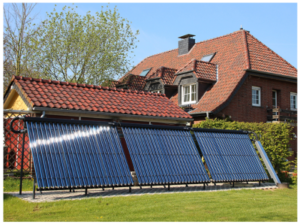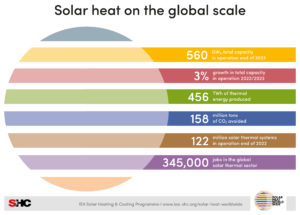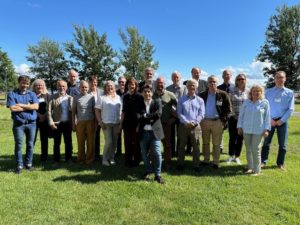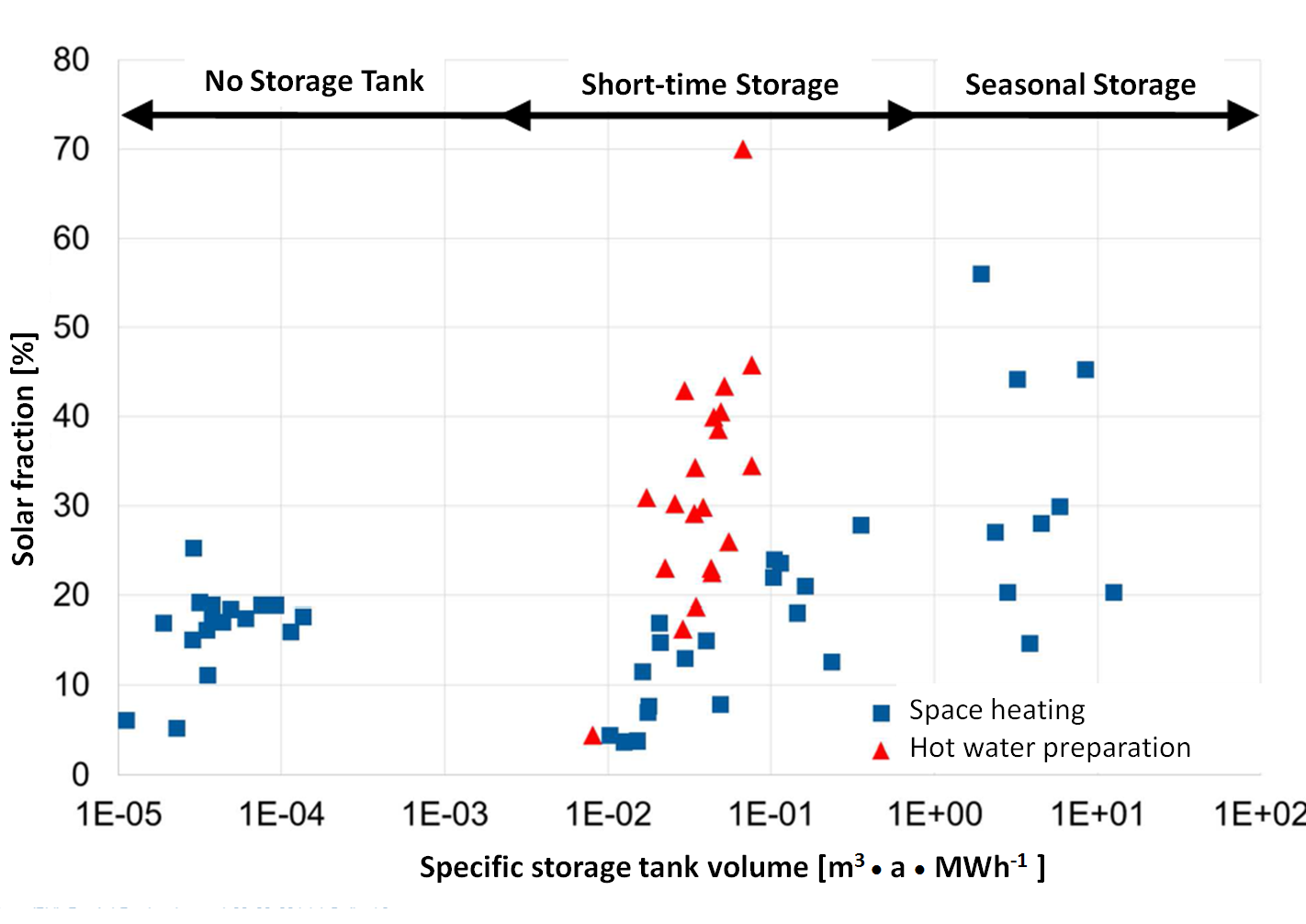
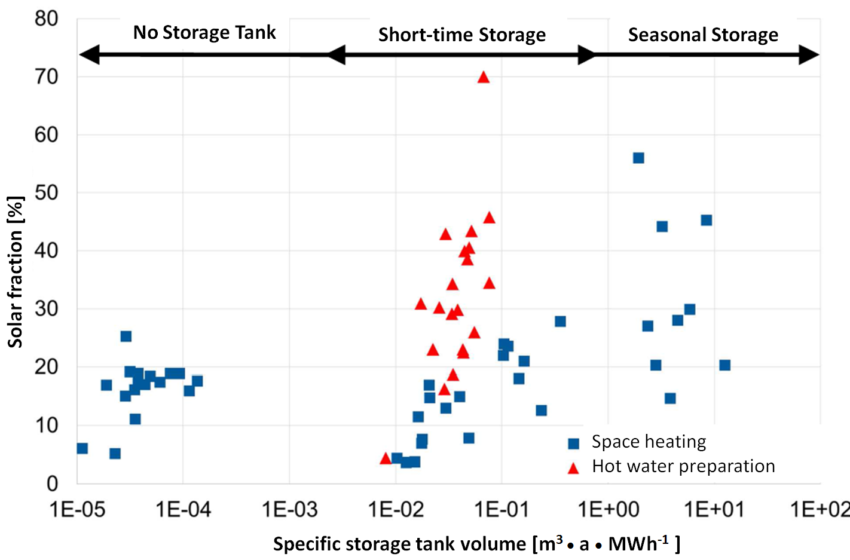
Europe: Performance and Cost Comparisons of Larger Residential Solar Thermal Systems
 As solar thermal installations have been a rare sight at Germany’s multi-family houses, the country’s Institute of New Energy Systems (InES) at the University of Applied Sciences in Ingolstadt took a closer look at Europe’s currently available larger solar thermal systems for domestic hot water and space heating. Daniel Beckenbauer, researcher at InES, counted 29 German collector installations above 100 m², as well as 47 systems in other European countries by surveying existing literature, web-based monitoring and other research programmes. Beckenbauer chose parameters such as solar share, investment costs and solar heat prices to compare these systems and to analyse the system designs offered on the market today. The chart above shows the monitored solar share based on the system’s specific storage volume. Because there are great differences in this volume between the surveyed projects, the x-axis has been divided logarithmically, spreading from 0.01 litre per MWh consumed heat per year (1E-05) to 100 m³ per MWh annually (1E+02).
As solar thermal installations have been a rare sight at Germany’s multi-family houses, the country’s Institute of New Energy Systems (InES) at the University of Applied Sciences in Ingolstadt took a closer look at Europe’s currently available larger solar thermal systems for domestic hot water and space heating. Daniel Beckenbauer, researcher at InES, counted 29 German collector installations above 100 m², as well as 47 systems in other European countries by surveying existing literature, web-based monitoring and other research programmes. Beckenbauer chose parameters such as solar share, investment costs and solar heat prices to compare these systems and to analyse the system designs offered on the market today. The chart above shows the monitored solar share based on the system’s specific storage volume. Because there are great differences in this volume between the surveyed projects, the x-axis has been divided logarithmically, spreading from 0.01 litre per MWh consumed heat per year (1E-05) to 100 m³ per MWh annually (1E+02).
Figures: Institute of New Energy Systems (InES)
The chart includes systems for domestic hot water (red triangles), whose solar share is based on annual hot water demand, and combi systems for hot water preparation and space heating (blue squares), whose share is based on the entire heating demand of the housing area supplied. The hot water systems show a clear linear trend: Increases in solar share go hand in hand with larger storage tank volumes. Quite the opposite is true for the space heating systems: The solar share increase is a lot less pronounced at larger storage tank volumes. The best installations do not achieve a share of more than 50 % of total heat demand. Some of the first demonstration plants underperformed at a solar share of below 20 %. This is the same share as achieved by tankless collector fields in Denmark, which feed solar energy directly into district heating networks and are marked in the above chart as blue squares on the very left.
 Solar heat prices depending on specific storage tank volume. The considered investment costs are comprised of total net values without any incentive deductions. The heat prices for all systems have been calculated by using the same parameters: Annual, fixed-rate loan payments over 20 years with an interest rate of 6 %.
Solar heat prices depending on specific storage tank volume. The considered investment costs are comprised of total net values without any incentive deductions. The heat prices for all systems have been calculated by using the same parameters: Annual, fixed-rate loan payments over 20 years with an interest rate of 6 %.
Low solar share systems show great potential in supplying residential housing areas
The chart above shows solar heat prices calculated based on specific storage tank volume. The systems are spread out across the logarithmically divided x-axis. There are no clear trends, besides the fact that systems with larger storage tanks have had significantly higher heat charges. The clear winners are the Danish installations without storage systems: They achieve prices below 70 EUR/MWh (left corner of the chart) and can even beat diesel generation under certain conditions, which leads the authors of the survey to conclude that systems with a low solar share have great potential in supplying residential housing areas. “Many existing housing areas do not have adequate roof space for large collector fields or open space for seasonal storage,” Beckenbauer explains. “We need standardised systems with decentralised solar energy feed-in locations and short-term storage systems for projects with space restrictions.”
The results presented above are part of a pre-study in research project smartSolgrid – Solar Smart Grids for the Heating Sector, which has been financed by the German Federal Ministry for Economic Affairs and Energy. The key task of the project is to plan, design and install a decentrised solar energy feed-in solution in an existing district heating network by housing association GWG in Ingolstadt. The project started in March 2013 and will end in February 2016. Connecting the solar systems to the district heating grid is a step planned for next year.
More information:
http://www.thi.de/go/energy
http://www.regin-plus.de/fileadmin/user_upload/Projektsteckbriefe/SmartSOLgrid.pdf (German only)
http://www.regin-plus.de/fileadmin/user_upload/Projektsteckbriefe/SmartSOLgrid.pdf (German only)
